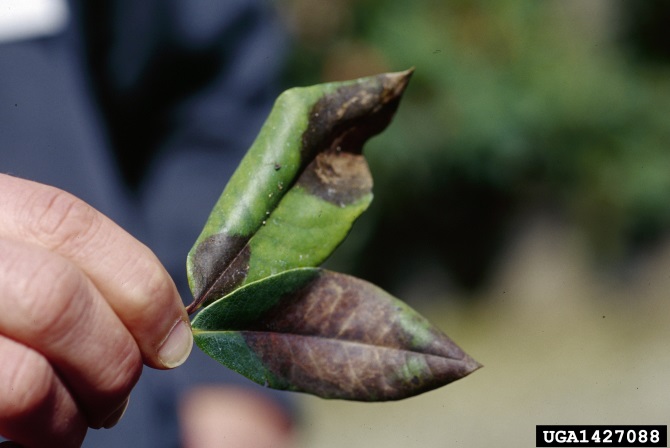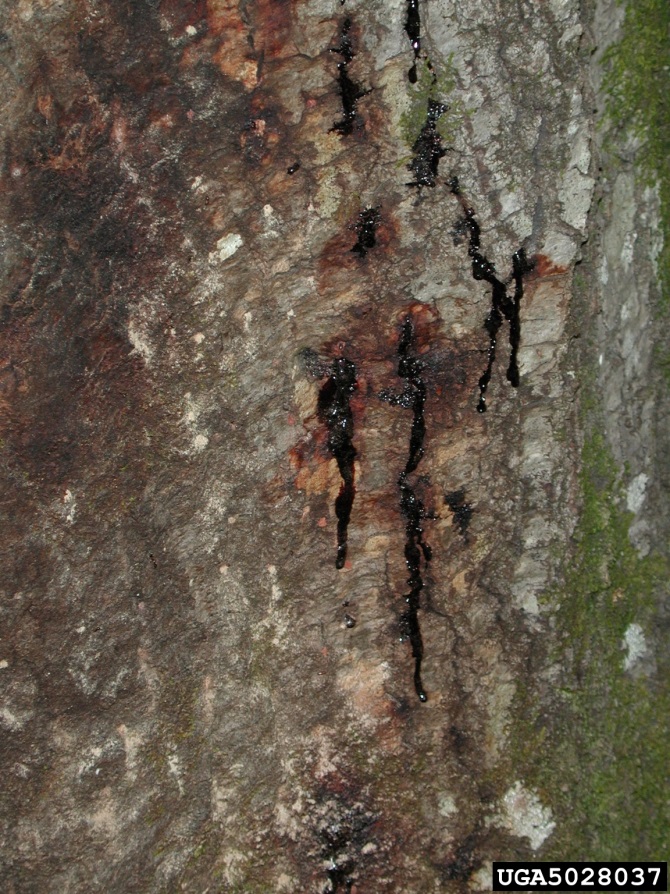
Sudden oak death
| Primefact number | Edition | Published | Author |
|---|---|---|---|
| 1474 | Second | Jan 2018 | Plant Biosecurity and Product Integrity |


Sudden oak death (Phytophthora ramorum) is an exotic plant pest not present in Australia. This disease is a serious threat to Australia’s forestry, nut and nursery industries.
The sudden oak death pathogen is known to infect over 130 plant species. Symptoms vary depending on the plant species affected. The disease cannot be identified based on field symptoms alone.
Phytophthora ramorum differs from most other Phytophthora species by affecting aerial parts of the plants rather than the roots.
Notifiable status
Sudden oak death (Phytophthora ramorum) is a notifiable plant disease in NSW.
All notifiable plant pests and diseases must be reported within 1 working day. You can report notifiable plant pests and diseases by one of the following methods:
- Call the Exotic Plant Pest Hotline 1800 084 881
- Email biosecurity@dpi.nsw.gov.au with a clear photo and your contact details
- Complete an online form
A full list of notifiable plant pests and diseases can be found in Schedule 2 of the NSW Biosecurity Act 2015.
Description
There are three common disease symptoms caused by P. ramorum:
- stem or trunk canker
- leaf blight
- twig dieback
Infected plants may display one or more of these disease symptoms.
Shrubs typically show symptoms of blackened shoots and dark brown blotching of leaves (Figure 1). Starting at the leaf tip, the brown lesions spread to cover the entire leaf over time.
Trees often develop stem cankers in branches and on the lower portion of the trunk. Red to black thick sap oozes from the bark surface with the sunken discoloured cankers observed beneath (Figure 2).
Rapid dieback of branches is observed when expanding cankers restrict the movement of water and nutrients. This is known as girdling.
Damage
Sudden oak death can be lethal to host species that develop trunk cankers. As cankers expand and girdle the tree the movement of water and nutrients is restricted. Girdled trees will continue to look healthy until all resources are depleted, after which they undergo rapid decline. Girdling of highly susceptible species can occur within a few weeks of infection.
Host death is less likely in species that primarily develop foliar symptoms. Foliar infections can lead to premature leaf death and drop. Yield is reduced in commercial hosts and the quality of nursery plants is impacted.
In natural forests, tree mortality could have a negative impact on biological diversity and lead to broader environmental problems.
Lifecycle
The infection of host plants by P. ramorum canoccur across a wide range of environmental conditions (10–30°C and 62–100% relative humidity).
When relative humidity is high, fungal spores are produced on previously infected leaves. These spores are readily spread by wind and water to infect new hosts.
Germination of P. ramorum spores occurs within a few hours of initial contact with the host plant. The fungus grows through the plant tissue, absorbing nutrients and killing plant cells.
Phytophthora ramorum is also able to survive in infested soil. It is possible to experimentally infect leaves by placing them over infested soil and it is possible to infect wood by placing it under infected leaves.
Host range
Phytophthora ramorum is known to infect over 130 tree and shrub species across 37 plant families.
Common ornamental host species include azalea (Rhododendron spp.), Camellia spp., common beech (Fagus sylvatica), elder (Sambucus nigra), fir (Abies spp.), horse chestnut (Aesculus hippocastanum),larch (Larix spp.), Magnolia spp., maple (Acer spp.), oak (Quercus spp.), Pittosporum undulatum and Viburnum spp.
Common commercial host species include avocado (Persea americana), blueberry (Vaccinium spp.), chestnut (Castanea sativa), hazelnut (Corylus spp.) and macadamia (Macadamia tetraphylla).
Spread
Phytophthora ramorum is spread locally by wind and water assisted movement of fungal spores.
While most foliar hosts are not killed by the disease, they do play a key role in the spread of P. ramorum, acting as a source of fungal spores.
Long distance spread of the pathogen occurs with the movement of infected plant material or soil.
Distribution
Phytophthora ramorum is found throughout North America and Europe.
Actions to minimise risk
Put in place biosecurity best practice actions to prevent entry, establishment and spread of pests and diseases:
- practice “Come clean, Go clean”
- ensure all staff and visitors are instructed in and adhere to your business management hygiene requirements
- monitor your plants regularly
- keep records

